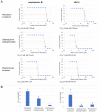Allicin as a Volatile or Nebulisable Antimycotic for the Treatment of Pulmonary Mycoses: In Vitro Studies Using a Lung Flow Test Rig
- PMID: 35743050
- PMCID: PMC9224539
- DOI: 10.3390/ijms23126607
Allicin as a Volatile or Nebulisable Antimycotic for the Treatment of Pulmonary Mycoses: In Vitro Studies Using a Lung Flow Test Rig
Abstract
Fungal infections of the lung are an increasing problem worldwide and the search for novel therapeutic agents is a current challenge due to emerging resistance to current antimycotics. The volatile defence substance allicin is formed naturally by freshly injured garlic plants and exhibits broad antimicrobial potency. Chemically synthesised allicin was active against selected fungi upon direct contact and via the gas phase at comparable concentrations to the pharmaceutically used antimycotic amphotericin B. We investigated the suppression of fungal growth by allicin vapour and aerosols in vitro in a test rig at air flow conditions mimicking the human lung. The effect of allicin via the gas phase was enhanced by ethanol. Our results suggest that allicin is a potential candidate for development for use in antifungal therapy for lung and upper respiratory tract infections.
Keywords: Paecilomyces; allicin; antimycotic; lung infection; mycosis.
Conflict of interest statement
The authors declare no conflict of interest.
Figures








Similar articles
-
Combating Black Fungus: Using Allicin as a Potent Antifungal Agent against Mucorales.Int J Mol Sci. 2023 Dec 15;24(24):17519. doi: 10.3390/ijms242417519. Int J Mol Sci. 2023. PMID: 38139348 Free PMC article.
-
Diallylthiosulfinate (Allicin), a Volatile Antimicrobial from Garlic (Allium sativum), Kills Human Lung Pathogenic Bacteria, Including MDR Strains, as a Vapor.Molecules. 2017 Oct 12;22(10):1711. doi: 10.3390/molecules22101711. Molecules. 2017. PMID: 29023413 Free PMC article.
-
Allicin enhances the oxidative damage effect of amphotericin B against Candida albicans.Int J Antimicrob Agents. 2009 Mar;33(3):258-63. doi: 10.1016/j.ijantimicag.2008.09.014. Epub 2008 Dec 17. Int J Antimicrob Agents. 2009. PMID: 19095412
-
An overview of the antifungal properties of allicin and its breakdown products--the possibility of a safe and effective antifungal prophylactic.Mycoses. 2005 Mar;48(2):95-100. doi: 10.1111/j.1439-0507.2004.01076.x. Mycoses. 2005. PMID: 15743425 Review.
-
Current studies and potential future research directions on biological effects and related mechanisms of allicin.Crit Rev Food Sci Nutr. 2023;63(25):7722-7748. doi: 10.1080/10408398.2022.2049691. Epub 2022 Mar 16. Crit Rev Food Sci Nutr. 2023. PMID: 35293826 Review.
Cited by
-
Garlic-Derived Quorum Sensing Inhibitors: A Novel Strategy Against Fungal Resistance.Drug Des Devel Ther. 2024 Dec 28;18:6413-6426. doi: 10.2147/DDDT.S503302. eCollection 2024. Drug Des Devel Ther. 2024. PMID: 39749188 Free PMC article. Review.
-
Combating Black Fungus: Using Allicin as a Potent Antifungal Agent against Mucorales.Int J Mol Sci. 2023 Dec 15;24(24):17519. doi: 10.3390/ijms242417519. Int J Mol Sci. 2023. PMID: 38139348 Free PMC article.
References
-
- Solano Aquilar E., Negroni R., Meinhof W., Padilha-Gonçalves A., Pappagianis D., Iwata K., González Mendoza A., Graybill J.R. Systemic Mycosis. In: Orfanos C.E., Stadler R., Gollnick H., editors. Dermatology in Five Continents. Springer; Berlin/Heidelberg, Germany: 1988. pp. 355–376. - DOI
-
- Burns T., Breathnach S.M., Cox N., Griffiths C. Rook’s Textbook of Dermatology. 8th ed. Wiley-Blackwell; New York, NY, USA: 2013.
MeSH terms
Substances
Grants and funding
LinkOut - more resources
Full Text Sources
Medical

